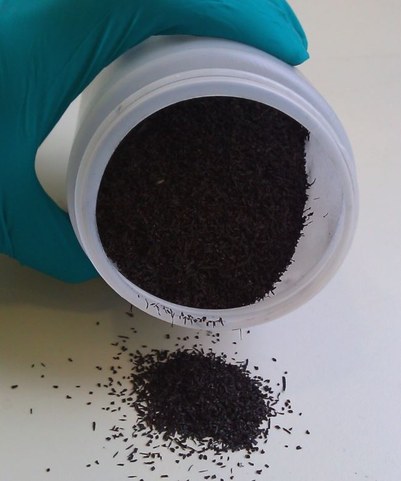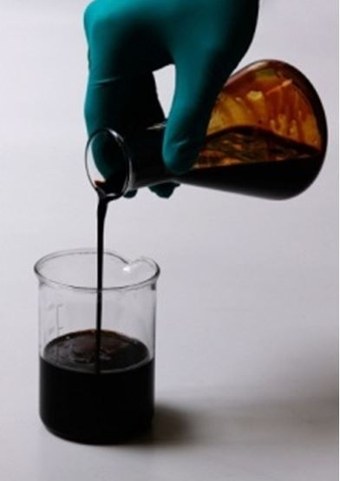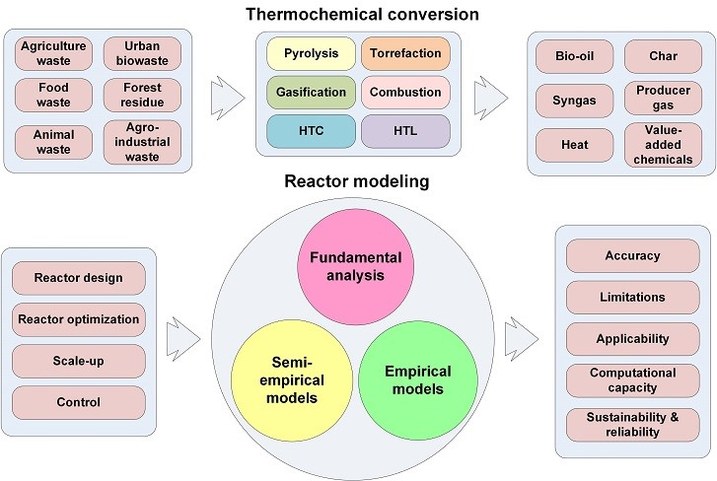Research
Slow pyrolysis
Slow pyrolysis is an ideal technology to produce biochar, which involves thermal decomposition in an inert atmosphere at a slow heating rate (∼10 °C/min) Pyrolysis converts solid fuels, such as coal and biomass, into char (solid), vapors of condensable hydrocarbons (called ‘oil’ for use after condensation) and non-condensable gases (e.g., CO, CO2, H2, and CH4). The yield of biochar, or char originating from biomass, is typically 20–40 wt.% of the original dry lignocellulosic biomass. However, the yield and characteristics of these pyrolysis products are strongly influenced by the operating conditions (temperature, heating rate, residence time, pressure, purge gas, and particle size) and the properties of the feedstock. The operating conditions of the pyrolysis process can be adjusted to meet the product requirements, however, the actual process needs to be carefully designed and performed.
Biochar is widely used for the generation of heat and power and addition to soils, in which it serves as a fertilizer and carbon sequestration agent. Next to that, biochar can also be upgraded to activated carbon either via a physical or chemical activation process. The obtained product can be used as an adsorbent in the purification of waste streams, supportive material for catalysts and for supercapacitors.
Fast pyrolysis
In contrast to slow pyrolysis, the focus of fast pyrolysis lies on the liquid product. Fast pyrolysis is a high temperature process in which biomass is rapidly heated in the absence of oxygen. As a result it decomposes to generate mostly vapours and aerosols and some charcoal. Liquid production requires very low vapour residence time (a few seconds) to minimise secondary reactions. After cooling and condensation, a dark brown mobile liquid is formed which has a heating value about half that of conventional fuel oil. Critical parameters that influence the product yield and it’s characteristics are the heating rate, heat supply and transfer, reaction temperature, vapour residence time, secondary cracking; char separation; ash separation; liquids collection and of course the nature of the feedstock and it’s pre-treatment.
Subsequently, it is also possible to modify the obtained pyrolysis oils by employing catalysts. Catalytic modifications to pyrolysis bio-oils are geared towards the elimination and substitution of oxygen and oxygen-containing functionalities in addition to increasing the hydrogen to carbon ratio of the final products. Recent progress has focused on both hydro-deoxygenation and hydrogenation of bio-oil using a variety of metal catalysts and the production of aromatics from bio-oil using cracking zeolites.
Hydrothermal treatments
Hydrothermal treatment (HTT) is a thermochemical conversion technique where wet biomass streams are converted to valuable products. This technique is performed in a reactor at temperatures ranging from 180 to 250 °C, under automatically generated pressure, with feedstock residence time ranging from 0.5 to 8 hours. The major advantage of HTT over other high temperature thermochemical conversion techniques such as pyrolysis, is this process treats wet waste, which allows feedstocks to be converted without pre-drying. A wide variety of feedstocks, including aquatic biomass, agricultural residues, and industrial and animal wastes, are suitable for. Water acts as a good medium for heat transfer in HTT, but if variability in the feedstock particle size is too large and reaction time is too short, there might be some mass transfer limitations. Hence, the particle size should be homogeneous to ensure uniform heat and mass transfer. The feedstock fed into the reactor is heated to a set temperature and held for a specified residence time. Gases and an aqueous slurry (mainly water with a small fraction of organics and solids) are produced during HTT. The aqueous slurry is centrifuged or filtered to separate the process water and solids. Like pyrolysis, there are two main routes, each focussing on a specific product: hydrothermal liquefaction and hydrothermal carbonization.
Alternative feedstocks
First- and second-generation biofuels use the lignocellulosic material of plants and convert it to biofuels, bio-chemicals and bio-products. The difference between the two is that the second-generation comprise the nonedible parts of plants and crops, excluding any competition with the food supply. Third-generation biofuels use algae as feedstock and require expensive technologically advanced equipment. However, algae’s ability to sequester CO2, produce relatively large amounts of lipids, grow in variable conditions, and grow orders of magnitude faster than all other plants make them an ideal biomass source for biofuel and bio-based chemicals.
In recent years the valorisation of municipal waste (sewage, food waste…) and waste from industrial processes (lignin, plastics …) is getting more attention. Depending on the nature of the feedstock, different types of products such as biofuels and biochemicals can be obtained.
Modeling thermochemical conversion of biomass
From a chemical point of view, thermochemical processes are highly complex and sensitive to numerous physicochemical properties, thus making reactor and process modelling more challenging. Nevertheless, the successful commercialization of these processes is contingent upon optimized reactor and process designs, which can be effectively achieved via modelling and simulation (kinetics, heat transfer, mass transfer …). Models of various scales with numerous simplifying assumptions have been developed for specific applications of thermochemical conversion of waste biomass. However, there is a research gap that needs to be explored to elaborate the scale of applicability, limitations, accuracy, validity, and special features of each model.


